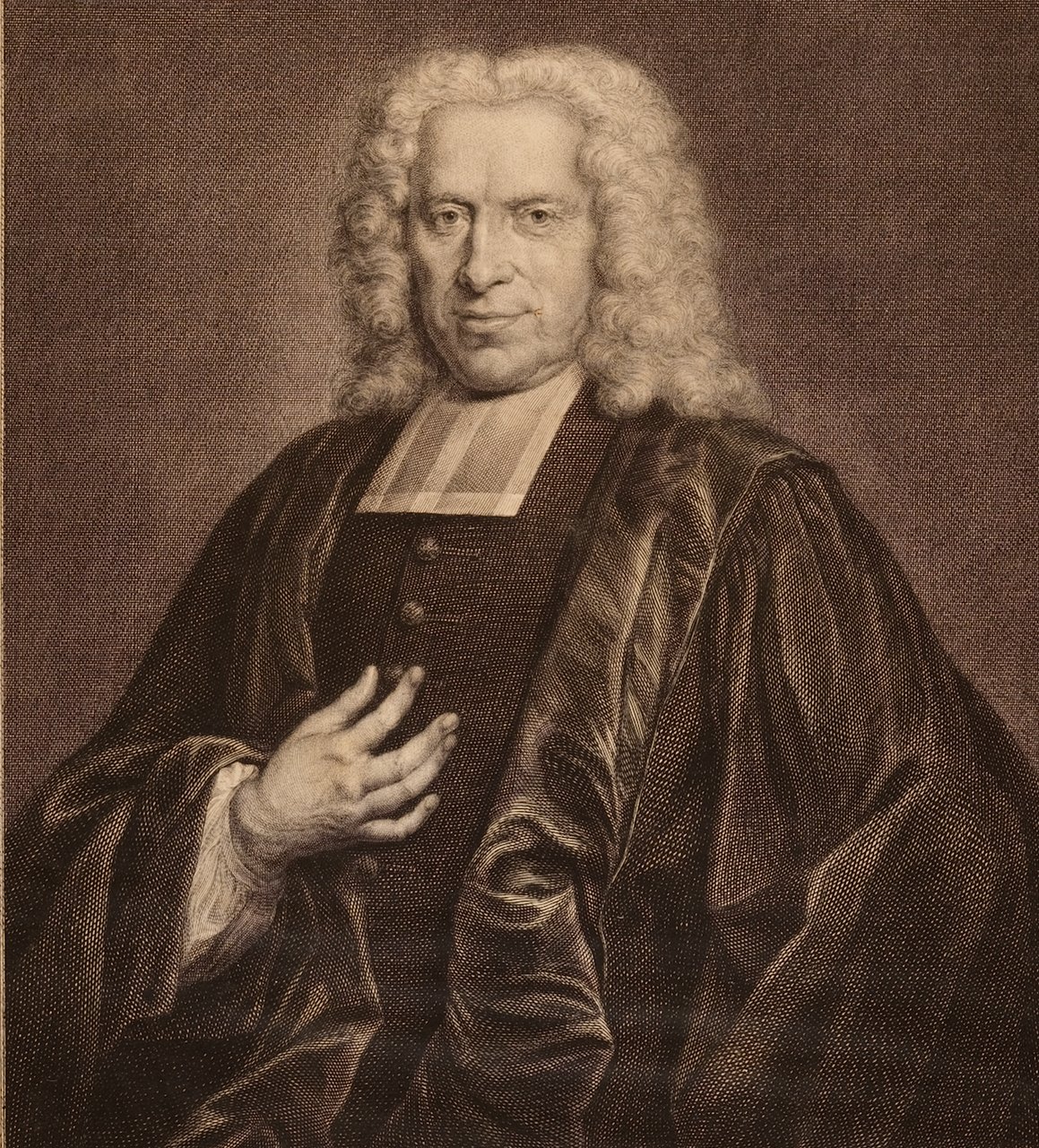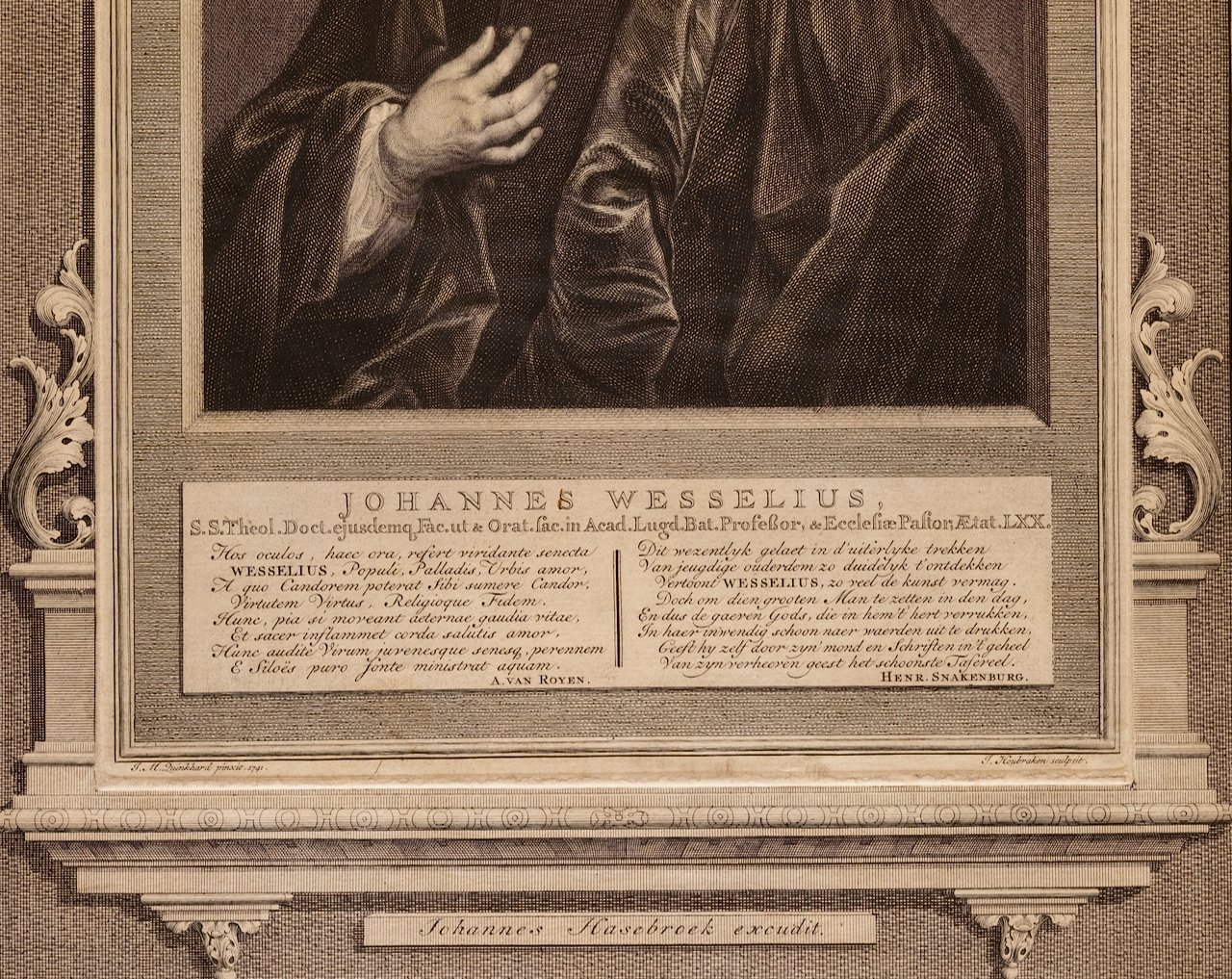Johannes Wesselius Portrait: An 18th Century Engraving/Etching by Houbraken
This is an 18th century engraved and etched portrait of Johannes Wesselius by Jacobus Houbraken after a painting by Jan Maurits Quinkhard. It depicts a half-height image of Wesselius dressed in the attire of a wealthy religious figure of the time with a sumptuous robe over his shirt and collar. His right hand appears to be reaching for a button on his shirt. There are two statements below the portrait, the one on the left in Latin and in Dutch on the right.
Creator: Jacobus Houbraken (1698 - 1780, Dutch)
Creation Year: 1741
Dimensions: Height: 19 in (48.26 cm)
Diameter: 13.5 in (34.29 cm)
Medium: Engraving, Etching
Condition: See description below.
This is an 18th century engraved and etched portrait of Johannes Wesselius by Jacobus Houbraken after a painting by Jan Maurits Quinkhard. It depicts a half-height image of Wesselius dressed in the attire of a wealthy religious figure of the time with a sumptuous robe over his shirt and collar. His right hand appears to be reaching for a button on his shirt. There are two statements below the portrait, the one on the left in Latin and in Dutch on the right.
Creator: Jacobus Houbraken (1698 - 1780, Dutch)
Creation Year: 1741
Dimensions: Height: 19 in (48.26 cm)
Diameter: 13.5 in (34.29 cm)
Medium: Engraving, Etching
Condition: See description below.
This is an 18th century engraved and etched portrait of Johannes Wesselius by Jacobus Houbraken after a painting by Jan Maurits Quinkhard. It depicts a half-height image of Wesselius dressed in the attire of a wealthy religious figure of the time with a sumptuous robe over his shirt and collar. His right hand appears to be reaching for a button on his shirt. There are two statements below the portrait, the one on the left in Latin and in Dutch on the right.
Creator: Jacobus Houbraken (1698 - 1780, Dutch)
Creation Year: 1741
Dimensions: Height: 19 in (48.26 cm)
Diameter: 13.5 in (34.29 cm)
Medium: Engraving, Etching
Condition: See description below.
This portrait is printed on laid, chain-linked paper with very wide margins. The sheet measures 19" high and 13.5" wide. There is spotting, discoloration and some wrinkling in the margins, none of which involves the image. There are three pinholes at the lower edge of the lower margin and one in each right corner, as well as a short tear at the edge of the right margin and a tiny tear at the left edge, which are professionally repaired on the verso. The print is held by several museums and institutions, including the Riksmuseum in Amsterdam.
Johannes Wesselius (1671-1745 ) was a Dutch philosopher and theologian born in 1671 in the town of Leeuwarden, in the province of Friesland, Netherlands. He studied theology and philosophy at the University of Franeker, where he obtained his doctorate in theology in 1696. He then worked as a pastor in various towns in the Netherlands before becoming a professor of theology at the University of Franeker in 1709. Wesselius was known for his contributions to philosophical and theological thought in the Netherlands during the early 18th century. He was a follower of the philosopher René Descartes and advocated for the use of reason and rational inquiry in theology. He wrote several works on philosophy and theology, including "Philosophia Rationalis," "Theologia Naturalis," and "Philosophia Practica." In addition to his academic pursuits, Wesselius was also involved in politics and served as a member of the Provincial States of Friesland, a legislative body in the Netherlands. He died in 1745 in Franeker, where he had spent much of his academic career. Wesselius is remembered for his contributions to the fields of philosophy and theology in the Netherlands during the early 18th century.
Jacobus Houbraken (1698-1780) was a Dutch engraver and portrait artist, considered one of the greatest of all time. He was born in Dordrecht, the Netherlands, and was the son of the famous Dutch artist Arnold Houbraken. Jacobus started his career as an engraver, and later became a portrait artist, creating portraits of famous people, including writers, philosophers, and statesmen. Houbraken's portraits were highly regarded for their accuracy and attention to detail, and he became known for his ability to capture the character of his subjects. His work was influenced by the Dutch Golden Age painters, and he was particularly interested in the use of light and shadow to create a sense of depth and realism. Jacobus created a technique which was similar to the great seventeenth century French school, most notably those of Nanteuil, Drevet and Edelinck. Houbraken was a key artist for the important work 'Heads of Illustrious Persons of Great Britain', published in London from 1743 to 1752. Working with the historian and artist, George Vertue, Houbraken engraved most of the important representations of Britain's most noted men from the past. Houbraken's greatest portraits, however, were his engravings based upon capturing the likenesses of his contemporaries. Here we see his precise and subtle use of the engraved line to its best advantage. These skills amazed most of Houbraken's fellow artists. A generation later, the famous Italian engraver, Raphael Morghen, remarked, "No engraver has ever equaled, and probably will not equal, the Dutchman Jacobus Houbraken, in the manner of imitating the flesh and the hair by means of the graver.".
In addition to his artistic work, Houbraken was also an important figure in the world of art education. He taught drawing and engraving at the Amsterdam Drawing Academy, and his students included many notable artists. He also wrote several books on art, including a biography of his father, which is considered an important source of information on Dutch art of the 17th century. Houbraken's work was widely celebrated during his lifetime, and he remains an important figure in the history of Dutch art. Today, his portraits are held in major museums around the world, including the Rijksmuseum in Amsterdam and the National Portrait Gallery in London.
Jan Maurits Quinkhard (1688-1772) was a Dutch painter and engraver known for his portraits, genre scenes, and religious works. He was born in Amsterdam, the son of a successful portrait painter, and began his artistic education in his father's workshop. Quinkhard continued his studies in Rome, where he was exposed to the works of Italian Renaissance painters and developed a more classicist style. He returned to Amsterdam in 1719 and became a member of the city's Guild of St. Luke. Quinkhard's portraits were highly sought after and he painted many prominent figures of his time, including members of the Dutch royal family. He also created religious works, such as altarpieces for churches, and genre scenes depicting everyday life. In addition to painting, Quinkhard was also an accomplished engraver and produced numerous prints of his own works and those of other artists. Quinkhard lived a long and productive life, continuing to work into his eighties. He died in Amsterdam in 1772 at the age of 84, leaving behind a significant body of work that continues to be admired for its technical skill and elegance.






























